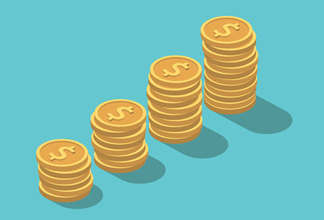Dividends, Dates & Terminology: Things to Know
Published on January 22, 2021
minute read
Share:
A dividend¹ is a cash distribution that is generally paid out from a company's earnings when a company chooses to transfer value to shareholders rather than reinvesting cash back into the business. Holding a dividend-paying stock can be a way of providing you with regular income (usually quarterly) while allowing for potential growth of your investment.
Here we cover some common terms around dividends and what they mean:
Declaration Date
This is the date that a company announces it is paying a dividend. A declaration statement is issued which includes details such as the size of dividend, the record date and the payment date.
Ex-Dividend Date (or Ex-Date)
In order to receive the next scheduled dividend, you must own the stock before this date.
If the stock is purchased on or after the ex-dividend date, the seller of the stock keeps the dividend.
Record Date (or Date of Record)
This is the date that you must be on the company's books as a shareholder of record to receive the dividend.
Payment Date
This is the scheduled date on which a company will pay a declared dividend to shareholders of record.
Hypothetical Example – Company ABC
On August 15, Company ABC declares a dividend payable on September 28 to its shareholders. Details stipulate that shareholders of record on the company's books on September 5 are entitled to the dividend, and that the stock would go ex-dividend on that date.
The table below puts it together with the key dates:
| Type | Declaration Date | Ex-Dividend Date | Record Date | Payment Date |
| Date | August 15 | September 5 | September 5 | September 28 |
| Note | The date the dividend is announced | The date before which you must own the stock to be entitled to the dividend. | The date by which you must be on the company's books as a shareholder to receive the dividend. | The date the dividend is paid to shareholders. |
Dividend Yield
This is the percentage of return a company pays out annually in dividends relative to its share price. Not all companies pay a dividend, so the presence of a dividend yield on a stock quote screen can often be viewed positively - as only profitable companies tend to share their earnings.
A stock's dividend yield is calculated by taking its annual dividend-per-share and then dividing it by the stock's current price. The result is then expressed as a percentage.
The formula is: Dividend yield = annual dividend / stock price x 100
As an example, Company ABC pays an annual dividend of $1.44, and the stock is trading at a price of $53.00. Using the formula above, Company ABC's dividend yield is 2.7 per cent.
It's important to realize that a stock's dividend yield is not guaranteed. It can vary in response to market fluctuations and the amount of the dividend the company chooses to pay, if any.
Fast Fact about Performance
Dividends are one component of a stock's total return. The other is the change in the share price over a period of time. For example, if a stock's price increased 5 per cent in the year and its dividend yield was 3 per cent, your total return would be 8 per cent if you held the stock the entire year.
On the flip side, if the stock's price declined 5 per cent in the year, you've still earned 3 per cent through dividends, so your total return would be negative 2 per cent.
If you're investing for the long term, it's worthwhile keeping the two parts of a stock's total return in mind. The simple equation is: Total return = Dividend yield + Price Change
Dividend Reinvestment Plan (DRIP)
A Dividend Reinvestment Plan automatically reinvests dividends into additional shares², which can be handy if you are receiving small amounts of cash. Look for 'DRIP eligible' under Quote Details on the Detailed Quote page .
Sellers and Ex-Dates
If you intend to sell a stock with a dividend reinvestment plan (DRIP) in place, the ex-dividend date is important to consider. When you sell an entire holding of a stock on or after the ex-dividend date, but before the DRIP is completed, you could end up holding a few residual shares you didn't count on. Another consideration is if you intend to transfer stocks internally from one account to another, the dividend may be paid out (in cash or stock) in the original account if transferred on or after the ex-dividend date, but before the payout is completed.
To check out dividend information on your stocks, enter a stock name or symbol into the search feature at the top right of any screen on the site. Select a stock and you will be directed to the Detailed Quote page where you'll find dividend information such as frequency, yield, pay date and ex-dividend date listed.
Remember, a high dividend yield alone does not measure up to a great investment, so it may be prudent to dig a little deeper. If you'd like to learn more about dividends, including risk, types and some handy ratios, read Dividends: Types, Ratios & Risks.
This article was updated in May 2025.
RBC Direct Investing Inc. and Royal Bank of Canada are separate corporate entities which are affiliated. RBC Direct Investing Inc. is a wholly owned subsidiary of Royal Bank of Canada and is a Member of the Canadian Investment Regulatory Organization and the Canadian Investor Protection Fund. Royal Bank of Canada and certain of its issuers are related to RBC Direct Investing Inc. RBC Direct Investing Inc. does not provide investment advice or recommendations regarding the purchase or sale of any securities. Investors are responsible for their own investment decisions. RBC Direct Investing is a business name used by RBC Direct Investing Inc. ® / ™ Trademark(s) of Royal Bank of Canada. RBC and Royal Bank are registered trademarks of Royal Bank of Canada. Used under licence. © Royal Bank of Canada 2025.
1 Dividends earned pursuant to DRIP may be subject to requirements imposed by the Income Tax Act (Canada). It is your responsibility to ensure that any associated tax requirements or obligations are satisfied.
2 The list of DRIP eligible securities is subject to change at any time without prior notice. RBC Direct Investing will purchase whole shares only. Some exclusions may apply. Some eligible securities such as preferred shares and voting class common shares will not reinvest into additional units of the same security but rather the underlying non-voting common share or similar security.
Images are for illustrative purposes only.
The views and opinions expressed in this publication are for your general interest and do not necessarily reflect the views and opinions of RBC Direct Investing. Furthermore, the products, services and securities referred to in this publication are only available in Canada and other jurisdictions where they may be legally offered for sale. Information available on the RBC Direct Investing website is intended for access by residents of Canada only, and should not be accessed from any jurisdiction outside of Canada.
Inspired Investor brings you personal stories, timely information and expert insights to empower your investment decisions. Visit About Us to find out more.










